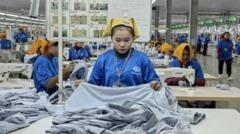Southeast Asia finds itself at a critical juncture as US tariffs on Chinese exports create a volatile trade climate. The tension, stemming from trade policies enacted during Donald Trump's presidency, forces countries like Vietnam and Indonesia to make challenging decisions about their economic future. Amidst increasing competition from Chinese goods, local businesses worry about surviving amid potential new tariffs on their products destined for the US market.
Vietnamese entrepreneur Hao Le heads SHDC Electronics and reports that his sales of phone and computer accessories, worth about $2 million monthly, could shrink dramatically if Trump reinstates tariffs of up to 46% on Vietnamese goods. Le highlights the competition from cheaper Chinese products in the Vietnamese market, emphasizing his company’s reliance on exports to the US. Similarly, many Southeast Asian businesses are alarmed about the implications of the tariffs, which could transform their economies dramatically.
In response to Trump's policies, South East Asian nations have been proactive in establishing economic deals to safeguard their markets. Following Trump's tariff announcement, Malaysian Trade Minister Tengku Zafrul Aziz asserted, “We can't choose, and we will never choose [between China and the US]," signaling the region’s diplomatic balancing act between the two economic powers.
While nations like Thailand and Indonesia are pursuing partnerships with the US to potentially ease or avoid new tariffs, they still face pressure from China's significant market presence and the complex web of trade flows within the region. As Chinese President Xi Jinping visits Southeast Asia to cement economic ties, leaders in the region must address how to navigate growing economic dependencies while advancing their own industrial agendas.
In this high-stakes environment, businesses are exhibiting resilience, with some, like Le's, reporting increased inquiries from American firms seeking alternative suppliers outside of China. Yet, the overall uncertainty poses equally compelling challenges. Economists warn that the unresolved tariff situation could harm local industries, leading to detrimental long-term effects.
As countries attempt to insulate themselves from external pressures, they are also experiencing burgeoning demand from global supply chains aiming to reduce dependence on China. However, many local businesses continue to struggle in the face of cheaper Chinese imports, leading to heightened protectionist measures across Southeast Asia.
While some sectors stand to benefit, the overall economic landscape remains uncertain. As nations weigh the potential impacts of US tariffs against their relationships with China, they must balance protective measures while embracing opportunities for collaboration. The region's economic stability hangs in the balance as it navigates these tumultuous trade waters.


















